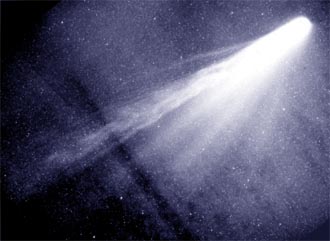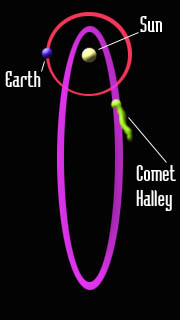pop up description layer
HOME
Cryptozoology UFO Mysteries Aviation Space & Time Dinosaurs Geology Archaeology Exploration 7 Wonders Surprising Science Troubled History Library Laboratory Attic Theater Store Index/Site Map Cyclorama
Search the Site: |
|
Comet Halley: Harbinger of Death?
Man has always found comets a bit scary. Other celestial dwellers that early man observed - the sun, moon, planets and stars - seemed to move and appear with predictable, if unexplainable, patterns. Comets were different. They might suddenly materialize without warning, expanding until their tails filled as much as a quarter of the sky, then fade into the depth of space just as quickly. It is little surprise then that the ancients attributed such displays to the gods. While a comet's appearance occasionally heralded positive events, like the birth of a king or success in coming battle, more often it was taken as a bad omen of disaster. The Fall of Jerusalem in 70 BC was "foretold" by a comet four years before. In 79 AD the eruption of the volcano Vesuvius which destroyed the city of Pompeii was attributed to a comet. In 1665 a comet preceded an outbreak of the Black Plague that killed almost 100,000 people in London. In 1835 a comet was blamed for such widely diverse events as the fall of the Alamo, a major fire in New Youk City and a massacre of 280 people in Africa. Halley Predicts a Comet Orbit
The understanding of what comets were and how they worked received a boost when astronomer Edmund Halley used Isaac Newton's recently formulated theories on the motion of bodies and gravity to predict the course of a comet he observed in 1682. He found that the object, unlike the planets which moved in near perfect circles around the sun, was traveling on an elongated orbit. Halley saw that this meant that the object would speed up as it drew closer to the center of the solar system and slow down at the farthest part of the orbit. He realized that a comet would spend most of its time at the edge of the solar system and only a brief time close to the center where it could be observed. This explained why comets were not visible for many years and why they suddenly appeared and disappeared. With this information about the orbit, Halley was able to surmise that the comet he had seen was the same one that had been observed in 1531 and 1607. He went on to predict that the comet would return in 1758. Halley did not live to see the return of the comet, but it did come again according to his calculations and because of that it now bears his name. At last the behavior of a comet could be explained and foretold. One might expect that with such information now available the fear of comets would easily subside. This was not to be the case. With the understanding of what comets were and how they moved a new concern arose. Suppose a comet collided with Earth? Or if there wasn't an actual collision could the pull of gravity from a passing comet set off earthquakes, volcanoes and other catastrophes? The predicted return of Halley's Comet became one of the first chances to fear a comet for scientific (or at least pseudo-scientific) reasons. In 1773 a paper written by the French mathematician Joseph de Lalande was misunderstood to predict a collision of the comet with earth leading to panic. People were so worried that unscrupulous clergy attempted to sell dispensations that would supposedly get the buyers into heaven. By 1910, however, astronomers were able to predict the path of the comet so accurately that only a few people were distressed by the possibility of Halley's comet hitting the planet. Now they feared its tail.
A Tail of Fear Obviously the most spetacular feature of a comet is its tail. In fact the word comet means "long-haired star." Scientists had speculated about what created a comet's tail for some time. Early theories pictured comets as balls of sand that slowly lost some of their grains as they traveled along leaving the tail. An analysis in 1950 by astronomer Fred Whipple, of Harvard University, indicated that if that was the case, the mass of the comet would quickly be depleted. Instead, Whipple suggested, comets were essentially "dirty snowballs" consisting of ice mixed with dust. When the comet was far from the sun, as it was for most of its existence, the comet was inert. As it moved closer to the sun, however, it warmed and the ice turned to gas (sometimes with explosive force) releasing the dirt or dust. The "solar wind" streaming out from the sun pushed the dust and gas in a single direction, creating the tail. Because the amount of time the comet is close to the sun is relatively small, not much of the total mass is lost with each orbit. The tail, like the head of the comet, does not shine itself, but reflects sunlight. In 1910 astronomers didn't know how the tail worked, but they did have an inkling of what it was composed. Thanks to the 1908 appearance of Morehouse's Comet scientists Chicago's Yerkes Observatory were able to analyze a comet's tail using the new science of spectroscopy.With it they were able to detect the presence of poisonous cyanogen gas in the tail. When two years later astronomers calculated that the Earth would pass directly through comet Halley's tail some people became concerned fearing that the gas would saturate the Earth's atmosphere and kill every living thing. Reaction to this perceived threat was predictable. Many people panicked. Scientists tried to calm fears by showing the amount of cyanogen gas in the tail to be so diffuse there was no chance of it getting into the air and reaching anywhere near the levels necessary to injure anyone. Less than honest entrepreneurs tried to capitalize on the event by selling "Anti-Comet Pills" at the rather high price of $1 per pill. Others offered gas masks or "Comet Protecting Umbrellas." Some organizations printed leaflets with advice:
While some people dreaded the poisonous cyanogen gas, others feared that the tail of the comet would bring deadly influenza. There were stories of farmers who were too busy preparing for the end of the world to bother to plant crops. One paper from Louisville reported that "Preparations for the end of the world are being made today by the ignorant persons through central and eastern parts of Kentucky." Near Memphis, Tennessee, there were reports of people following a prophet who proclaimed that the comet would destroy the world at noon on May the 18th. In Philadelphia, Pennsylvania, newspapers reported that the Rev. Abraham Lincoln Johnson was holding revival meetings where his congregation was "reduced to a paroxysm of fear" as the preacher pictured the destruction the comet would bring. In Italy, farmers were blaming floods and unseasonable weather that destroyed their crops on the celestial visitor. Most responsible newspapers tried to quell people's fears. An editorial in the Boston American for May 18th, 1910 reads:
Comet Hoaxes and Fictions Other newspapers added to the fear by running stories that turned out to be hoaxes. The Oklahoma City Times ran a front page story about an incident that supposedly happened the night the comet passed:
As far as any modern researcher can conclude, the above story and a similar one run in the Washington Post was totally fabricated, though widely believed by the public at the time.
The idea that the planet could be plunged into a zone of death that would kill everything on it also inspired writers. Two years after the comet, Sir Arthur Conan Doyle published his tale, The Poison Belt about a band of explorers who manage to survive while the rest of the Earth's population perishes when the planet passes through a deadly region in space. As recently as 1984, the film, Night of Comet, depicted two high school girls surviving the visit of a comet that turns all other human life to red dust or cannibalistic zombies. Not everybody treated the 1910 arrival of comet Halley with fear, however. Much of the memorabilia from that year features the comet in a whimsical or mocking way. Two popular song sheets sold at the time were "A Trip to the Moon" (as a way of avoiding being on Earth when the comet passed) and "Halley's Comet Rag." Cartoons, greeting cards and products from that era display the comet prominently. Many people heralded the arrival of the comet with celebrations and "comet" parties that were abundant both in the United States and Europe. As the writer in the Boston American had predicted, the comet passed without incident and world soon got over its excitement. One might have expected after the 1910 passage caused no problems predictions that comets would cause massive destruction might have abated. This was not the case. In 1996, comet Hyakutake and in 1997, comet Hale-Bopp both were rumored to be "doomsday" comets. Both passed by the Earth without hitting it or even causing any of the predicted earthquakes or volcanic eruptions. There was a sad footnote to the passage of Hale-Bopp, however, as 39 members of a religious cult committed suicide, apparently believing they would be taken aboard a UFO hiding behind the comet. Comet Legacy Even though we know of no comet that has ever injured a human being, they do pose a threat to life on Earth. There remains a small chance that a comet could collide with the planet causing widespread destruction. In 1908, something exploded above Siberia with the force of an H-bomb. Though most recent theories point to a stony meteorite, some scientists have speculated that the object was a comet. Whatever it was, if it had hit three hours earlier, the explosion would have destroyed the city of Moscow with all its inhabitants. While the exact cause of the Siberian blast is still under debate, nobody doubts that a large comet would be capable of creating a similar disaster. In 1994, the remains of comet Shoemaker-Levy 9, which had split up into several pieces, collided with the planet Jupiter. The fireballs and disruptions to the planet's atmosphere were easily visible to Earth's telescopes millions of miles away. Still, as much as there is a small chance that comets might create destruction on Earth, they may have made life possible, too. Early in the Earth's history, scientists think collisions with comets deposited a significant amount of water on the planet, helping to form our oceans. Comets may have also contributed organic material necessary for life. Without these we might not be here today to observe comets, whether we choose to fear their destructive power, or celebrate their beauty. Want to read this article in Belorussian? Click Here! Copyright Lee Krystek 1997-2008. All Rights Reserved. A Partial Bibliography Comets: Creators and Destroyers, by David H. Levy, Touchstone: Simon & Shuster Inc., 1998. Rocks From Space, by O. Richard Norton, Mountain Press Publishing., 1998. Halley's Comet: Memories of 1910, by Roberta Etter and Stuart Schneider, Abbeville Press, 1985 The Virgin and the Comet, by Guy W. Moore, Halley's Comet Watch Newsletter, http://www.geocities.com/athens/olympus/6745/VirginandcometI |
|
Related Links |
|
|








